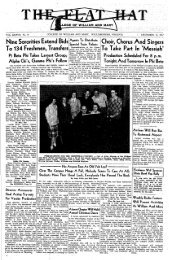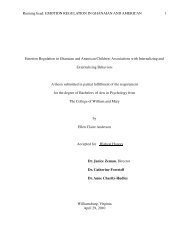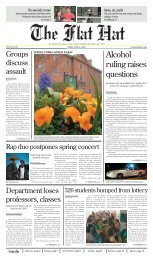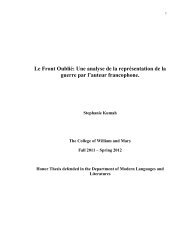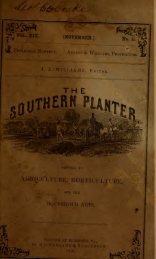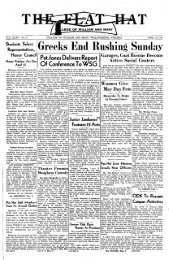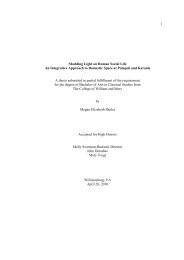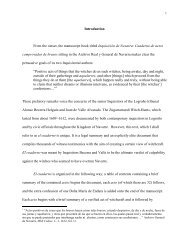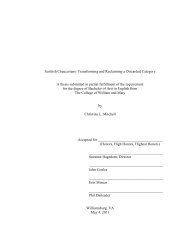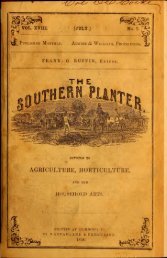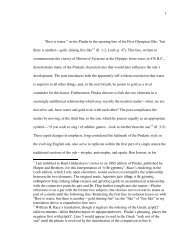Southern planter - The W&M Digital Archive
Southern planter - The W&M Digital Archive
Southern planter - The W&M Digital Archive
Create successful ePaper yourself
Turn your PDF publications into a flip-book with our unique Google optimized e-Paper software.
414 THE SOUTHERN PLANTER. [July<br />
until fcha natural law has increased the<br />
price ; and the next question of any im-<br />
portance is, whether that diminution is permanent,<br />
and it' so, why?<br />
We do not mean to be understood that<br />
there is a real diminution of food-producing<br />
animals, but only a relative one to the<br />
consumers. <strong>The</strong> case is just this: A man<br />
and his wife, in commencing life, fatted<br />
and killed one hog every fall for their supply<br />
of winter meat, and the supply was suf-<br />
ficient for the demand. But in due course<br />
of time there was an increase of mouths,<br />
till the number to be filled was quadrupled,<br />
and then the one hog was insufficient for<br />
them all; and if they had not been<br />
contented to continue to make an equit-<br />
able division of the flesh between all<br />
the mouths, it is probable that one would<br />
have outbid the other, and so enhanced<br />
the price in money to those who did not<br />
consume it. Now, is this the case with,<br />
the people of the United States? Has<br />
the family become too large for the na-<br />
tional pig-pen ?<br />
We lay it down as an axiom, that domestic<br />
animals decrease as human beings<br />
increase. China is a witness of this fact j<br />
j<br />
and so is our own country, though it has<br />
j<br />
not generally been supposed that this re-<br />
it is said, though somewhat figuratively, can-!<br />
not lie, prove that the diminution has commenced<br />
j and the increase of prices further<br />
prove that the supply is insufficient for the<br />
demand ; so that the high prices are a legitimate<br />
result j and that they will not recede<br />
permanently, becomes a moral cer-<br />
tainty. <strong>The</strong> increase of population rela^<br />
tive to the increase of animals, particularly;<br />
the non-producing class of persons, such as<br />
suring them that good beef cattle would always<br />
sell at prices equivalent to the ten<br />
cents a pound for the meat, and that they<br />
could better afford to make beef at that than<br />
to grow grain at the general average price.<br />
We were asked last spring, by one farmer,<br />
if we really believed that beef cattle would<br />
be worth this price the present fall; and<br />
assured us if he could think so, that he<br />
would buy and feed a hundred bullocks;<br />
but his opinion was that the Great West<br />
was so full of cattle, that prices must come<br />
down. On the contrary, with much less<br />
packing, the price has advanced beyond the<br />
anticipations of the most shrewd men engaged<br />
in the business of feeding, and buying<br />
and selling beef cattle. It is highly<br />
important for producers and consumers and<br />
dealers to inquire for the cause, and see if<br />
they can think, as we do, that the present rates<br />
will continue so, as to base their operations<br />
upon the new truths they may discover.<br />
In proof of our proposition, we offer the<br />
following tables, which we find ready prepared<br />
to our use in the Cincinnati Gazette,<br />
in an article taking the same view we do,<br />
that the general production of the country<br />
is insufficient for the consumption the people<br />
have accustomed themselves to during a<br />
long period of low prices—that is compar-<br />
lative diminution had taken place in the: tively low with the present, as the present<br />
United States to a degree sufficient to per- here are with prices in the older countries<br />
manently affect the supply and price of the of Europe.<br />
three great feed-producing class of ani- <strong>The</strong> first table shows the United States<br />
mals. Facts derived from figures, which,! census at two decades, of animals, and the<br />
per cent, increase of each, and compara-<br />
tive per cent, increase of population.<br />
NUMBER AND INCREASE OF CATTLE IN<br />
THE UNITED STATES.<br />
Animals. 1840. 1850. Ratio of in.<br />
Horses and<br />
Mules, 4,385,399 4,896,060 13 pr ct.<br />
Neat Cattle, 14,971.586 18,378,907 24 pr ct.<br />
Swine, 26,201,293 30,854,213 16 pr ct.<br />
Sheep, 19,111,374 21,723,290 13 pr ct.<br />
Increase of population, 35 pr ct.<br />
reside in cities, or are engaged in other em- It will strike every one with force that<br />
ployments than farming, is much greater population has increased so much faster than<br />
than we would believe possible, but for the cattle. <strong>The</strong> "bullocks have increased only<br />
proof of the figures found in the census re- two-thirds as fast as the people, and the<br />
turns. Again, another reason of short sup- swine only half as fast, in all the country,<br />
ply for home consumption, is the increased while in twelve of the oldest States the fol-<br />
exportation of all animal products, and that lowing table shows just what we have al-<br />
is more likely to grow larger than it is to' leged, that an increase of population, and<br />
decrease.<br />
We have been for years endeavouring to<br />
more extensive subjugation of wild lands<br />
to domestic purposes has a tendency to de-<br />
encourage farmers to increase the supply of crease the number of domestic animals, and<br />
meat in this great emporium, constantly as- produce the necessity for the people to



